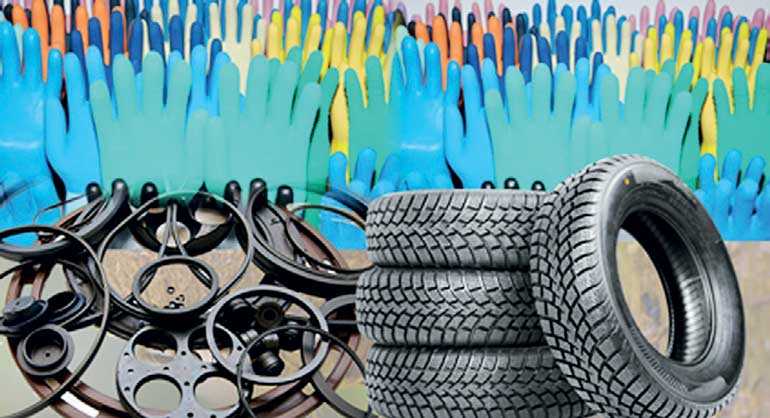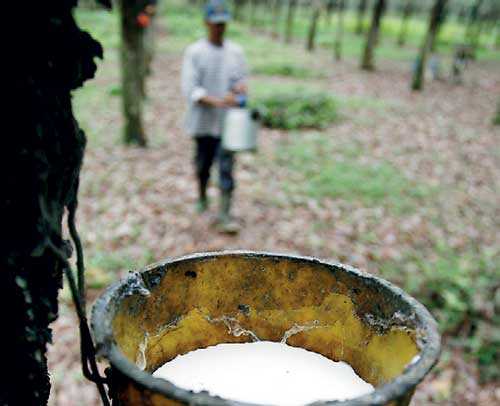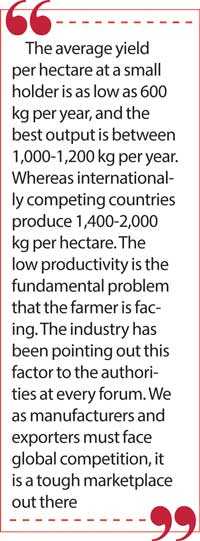Saturday Mar 29, 2025
Saturday Mar 29, 2025
Tuesday, 15 September 2020 00:18 - - {{hitsCtrl.values.hits}}

The public and most authorities do not realise that Sri Lanka’s production of natural rubber is far less than the demand
In an interview with the Daily FT, Sri Lanka Association of Manufacturers and Exporters of Rubber Products (SLAMERP) Director General Rohan Masakorala explained the current position of the rubber industry and its potential to increase export revenue. Following are excerpts of an interview:
Q: Could you briefly explain the role of SLAMERP?
Sri Lanka Association of Manufacturers and Exporters of Rubber Products (SLAMERP), was established in 1985; it was a result of an initiative taken by a small group of rubber products manufacturers to form an association to promote the business interests of the rubber industry that was in a transition period at that time into value addition. The sector represents the value-added businesses of the rubber supply chain, which produces high end products mainly exporting to the international markets, competing with international players, and is also producing products that are required by the domestic market. Out of the total rubber industry value of $ 900 million plus in Sri Lanka, SLAMERP accounts for 90% of it, creating 37,000 jobs directly and well over 100,000 jobs indirectly.
|
SLAMERP Director General Rohan Masakorala
|
Q: Could you briefly describe the global natural rubber industry?
Asia is considered as the world’s crucial sources of rubber especially Southeast Asian countries that have hot weather and monsoon climate which are significantly conducive to rubber tree cultivation. Thailand, Indonesia, and Malaysia are the top three producers representing 75% of the global rubber output. Sri Lanka rubber industry goes back to 150 years and relatively small in scale and it was during the British era the plantations were introduced.
Natural rubber is derived from a rubber plant and it constitutes around 45% of the total rubber consumption globally. In 2018, Asia Pacific produced about 12.64 million tons of natural rubber. Thailand is considered as the world’s largest producer with 33.4% of the global natural rubber market share. Followed by Indonesia, Vietnam, China, and Malaysia that were accounted for 24.7%, 8.5%, 6.4%, and 3.8% respectively of the global market share, this is according to Krungsri research. The value chain of the global rubber industry is runs well over $ 250 billion and is estimated to reach $ 600 billion by 2027 and we have good space to increase our market share.
Q: Could you explain the rubber value chain?
The global rubber industry is dominated by solid tyres and pneumatic tyres. Other than that, the industry provides household and industrial gloves and rubber components for various machinery, equipment, and construction products. There is also a sophisticated high-tech component that are produced for niche markets. The supply chain on one side starts with the rubber tree at the farm gate and considerable amount of raw material comes from the petrochemical industry. Along with these two major components, comes in numerous numbers of chemicals, steel, fabric, and adhesives to develop high value-added products in the rubber world. As a result, the rubber supply chain has many players including farmers, petrochemical and chemical industry and other intermediary product manufacturers, traders, Government institutions and international networks. At the end of the value chain, it is the consumers, retailers that deal with the manufacturers and exporters for end products.
Q: In the recent past, reports say that in Sri Lanka, there had been attempts to artificially increase prices of raw materials by third parties. Is that correct?
This is somewhat true, given the misinformation shared with the policy makers. This is also a continuous problem that the industry is facing. There is an organised lobby of so-called middlemen, who are buying raw rubber from farmers, mostly below world market prices and then try to sell them to manufacturers at a higher price than the world market. This was quite evident recently. With the COVID-19 pandemic lockdown, where factories had to shut down for two weeks. Our manufacturers had existing stocks in inventory and international orders were also cut down severely due to the global situation.
However, domestic farmers continued to harvest rubber and stocks were building without a marketplace. This is where the third parties went and squeezed the farmer and brought their stock at extreme cheap prices between Rs. 180-210 per kg, all this whilst the manufactures were paying Rs. 250 to 260 per kg. Whereas, the global market, the rate was hovering around Rs. 230 kg at the same time. The manufacturers also had import orders of raw rubber that are usually brought in for the shortfall of rubber production in Sri Lanka.
Taking advantage of this situation, third-party lobbies went to the Government and painted a picture, saying that manufacturers are not buying rubber from the local market and at the same time lobbied Government authorities to force an artificial price increase of up to Rs. 300, so that they could sell their stocks bought at Rs. 180 at a very high price and make a killing. They were sighting the farmer as the affected party. This was to pressurise the Government during an election period.
However, the SLAMERP found that farmer stocks were mainly sold to middleman and managed to expose this situation to high authorities at Government and thankfully most of the policy makers have now understood the story behind this attempt. But the problem-occurs on and off which disturbs the production process and the price stability prevalent.
Q: Talking of imports, why do we need to import rubber?
The public and most authorities do not realise that Sri Lanka’s production of natural rubber is far less than the demand. The total production of the island has been coming down over the last two decades, from around 150,000 metric tons to 75,000 metric tons per year, while the demand for value addition, for export and domestic market is 150,000 metric tons. So, this is basic arithmetic to explain, why we must import to manufacture on time to cater to world market. The industry value addition is around 40% to 60%.
We also need to import certain qualities of rubber that cannot be purchased in Sri Lanka at given specs. Today many tyre manufacturers are moving from RSS rubber grade to TSR grade. However, the local supply is very low in TSR quality. We also must import chemicals and intermediary products that are needed for manufacturing. Our members have also noticed that in certain season the supply drastically drops in Sri Lanka due to weather conditions, so we also have to import buffer stocks to meet the international demand and add to that, today with the pandemic the demand for rubber gloves have increased by 30%.
Sri Lankan manufacturers are finding it extremely difficult to source enough latex from the local market. The price of the global natural rubber industry is set at global auctions in Singapore and Malaysia in this part of the world and our manufactures must align to it to be globally competitive.
Q: How do you perceive the local plantations industry and the productivity?
Plantations are extremely important for us as the rubber industry. In fact, investors have come to this country as we have a historical background of producing quality natural rubber. The plantations sector is divided between large scale plantations and the small holders. Unfortunately, Sri Lanka’s rubber industry at the primary level has not advanced in best management techniques, adapting technology and improving scale. As a result, the yield and the productivity levels are very low, compared to rubber producing top destinations such as, Thailand, Malaysia, Vietnam, China, etc.
The average yield per hectare at a small holder is as low as 600 kg per year, and the best output is between 1,000-1,200 kg per year. Whereas internationally competing countries produce 1,400-2,000 kg per hectare. The low productivity is the fundamental problem that the farmer is facing. The industry has been pointing out this factor to the authorities at every forum. We as manufacturers and exporters must face global competition, it is a tough marketplace out there.
This must be understood by the Government departments that has been set up under the planation ministry such as the Rubber Development Department (RDD) and the Rubber Industry Research Institute (RIRI) along with the rubber secretariat. One thing is clear International manufacturers are not willing to subsidies inefficiencies of the local systems.
Q: Recently the President has said that the Government was targeting to reach $ 2 billion of rubber exports by 2022, which is more than 100% increase. Can we do this?
Yes, this is absolutely possible, in the medium term we can certainly increase our value-added exports. But we need to implement the rubber master plan which came out officially in 2017. This document has recommended many structural reforms both vertically and horizontally for the sector. There is lot of commitment needed from the government to achieve this target. As an industry body, we have already engaged with the Board of Investment to set up a new Rubber Zone which is known as the “Rubber City Plan” of the Master Plan. We are also proposing key areas of importance to the government in the upcoming budget. In fact, industry is targeting a $ 3 billion industry by 2025. However, these targets may have new challenges with the economic downturn with COVID-19.
Q: What is the message that you would like to carry to the Government and the authorities?
SLAMERP is very confident that the Sri Lankan rubber manufacturing and export industry can grow and create new jobs and increase foreign exchange revenue if corrective measures are taken in few areas. I would like to list them as follows:
1. While it is extremely important to expand the rubber plantations industry (new plantations and re-planting), we need to attract new investments and new investors to the country. To do this, we need to have consistent policy and action plan implemented. Sri Lanka has already attracted major international brands along with world class local manufacturers. We need to give them confidence with long term policy stability.
2. We need to make sure that the rubber industry not only continue to manufacture and export, but they should be encouraged to be part of the global value chains and diversify. What I mean is, sometimes we may not be able to do the full product, but manufacture components. This model may attract new investments given our location in Asia.
3. The government should not intervene in anyway in the international marketplace derived pricing for input for value addition. There should not be any restriction on importation for shortage in local input, may it be due to low quality or seasonal production drops. Investors would always want flexibility and freedom to do manufacturing as competitiveness is the medicine for us to survive. Otherwise global brands can easily shift production from one country to another. So, we need to give clear signals that Sri Lanka will facilitate maximum competitiveness.
4. In achieving competitiveness in the global markets, we need to have proper and flexible labour laws, competitive energy prices, which includes electricity and furnace oil. We also should ensure lower transaction costs at border agencies with competitive freight costs and market access with FTAs to expand our client base across the world.
If we work towards this direction, I am confident that we can achieve our targets. In fact, as a closing remark, I would like to add a figure on what value addition means to Sri Lanka. At the beginning I said, we produce around 75,000 metric tons per year as natural and raw rubber. If we export this total volume at today’s world market prices as a commodity, we will earn less than $ 125 million. But, after importing the shortage, we export nearly $ 1 billion worth of value-added exports, which is a net revenue close to $ 700 million and many more jobs created in the supply chain. It is important that both government and officials understand this situation in international trade. This is the recipe of success of the Sri Lanka apparel industry too.
Discover Kapruka, the leading online shopping platform in Sri Lanka, where you can conveniently send Gifts and Flowers to your loved ones for any event including Valentine ’s Day. Explore a wide range of popular Shopping Categories on Kapruka, including Toys, Groceries, Electronics, Birthday Cakes, Fruits, Chocolates, Flower Bouquets, Clothing, Watches, Lingerie, Gift Sets and Jewellery. Also if you’re interested in selling with Kapruka, Partner Central by Kapruka is the best solution to start with. Moreover, through Kapruka Global Shop, you can also enjoy the convenience of purchasing products from renowned platforms like Amazon and eBay and have them delivered to Sri Lanka.
Discover Kapruka, the leading online shopping platform in Sri Lanka, where you can conveniently send Gifts and Flowers to your loved ones for any event including Valentine ’s Day. Explore a wide range of popular Shopping Categories on Kapruka, including Toys, Groceries, Electronics, Birthday Cakes, Fruits, Chocolates, Flower Bouquets, Clothing, Watches, Lingerie, Gift Sets and Jewellery. Also if you’re interested in selling with Kapruka, Partner Central by Kapruka is the best solution to start with. Moreover, through Kapruka Global Shop, you can also enjoy the convenience of purchasing products from renowned platforms like Amazon and eBay and have them delivered to Sri Lanka.